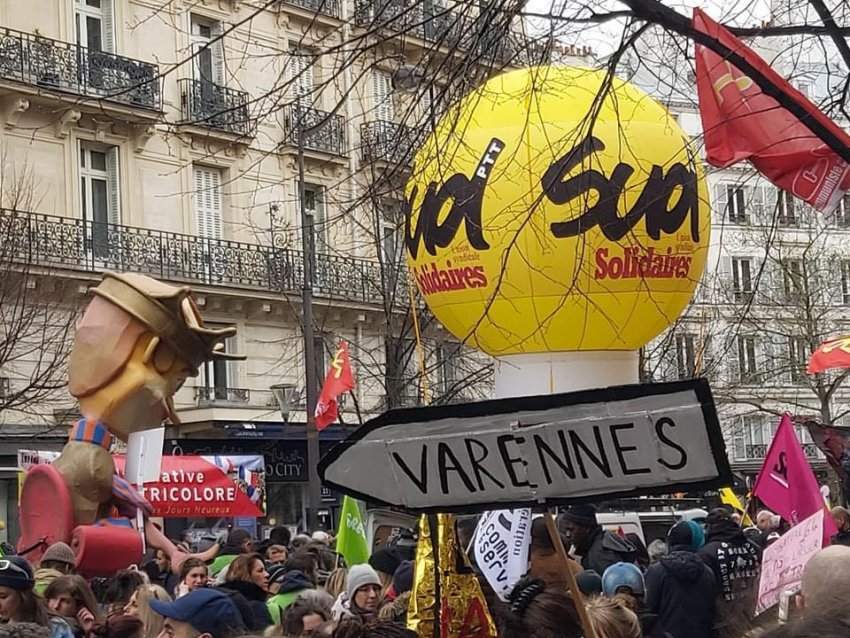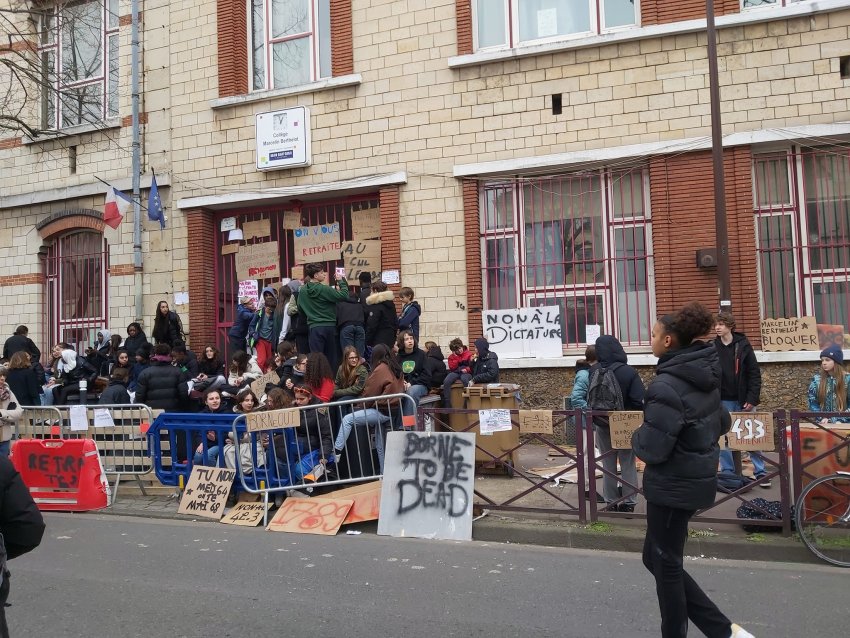
The huge movement against French President Emmanuel Macron’s attack on pensions is still erupting. Millions were on the streets on the tenth day of action on March 28, and numerous strikes continue — in some sectors moving into their fourth week.
Blockades of some motorways, ports, universities and high schools also show that the movement is not ready to give up. However, the national union leaderships are refusing to call a real general strike and are making worrying noises about “the need for arbitration”.
The latest polls show that 63% of the population “want the mobilisation to continue” and 40% want it “to get more radical”. We haven’t won yet, but we certainly haven’t lost yet.
Macron has sustained serious damage. He has been obliged to shelve some other vicious laws, and make concessions on other issues, such as student grants. Whatever happens, he will have to abandon most of the other neoliberal reforms he planned, and “Macronism” as a political force may well be dead in the medium term.
People from afar sometimes assume that all French people are born rebellious, or that we tell bedtime stories about guillotining the rich to instil radicalism in our children. But the present combativity and political class consciousness of workers — millions of those mobilising right now are not directly affected by the attacks on the pension system — has been built up over 30 years, since the first mass revolt to defend pensions, in 1995.
378 - French pensions movement 2023 cr John Mullen.jpg

Trade union influence
The movement is also rooted in the specifics of French trade union structures.
Trade union membership in France is considerably lower than, say, Britain. In the public sector, less than 20% of workers are members of a union, and in the private sector, less than 10%. However, these figures are misleading, and trade union influence is far wider than membership figures suggest.
Millions of non-members vote for, and are represented by, union candidates for health committees, company councils, regional wages councils, and other such bodies, which negotiate locally, regionally or nationally on health and safety, bonuses, promotions, transfers and working hours as well as on minimum wages and pay scales.
Agreements signed by trade unions on these bodies apply to all workers, union and non-union. Many workers see union members as activists, organisers and advisors whose job is to support and encourage individual workers and to lead various fight-backs, whether or not the workers involved are themselves union members.
Large numbers of the workers who have taken strike action in the public sector this month are not union members. The right to strike is part of the French constitution, and non-union workers are legally protected by the strike declarations made by unions. Relatively solid legal protection means that it is very common, on days of action, to have minorities in a workplace taking strike action. In one railway depot there might be 20% of strikers, in another 80% and so on.
A key historical weakness of the union movement here is its division into — sometimes competing — confederations, of which the most important are the Confédération Générale du Travail (CGT), which has 640,000 members, Force Ouvrière (FO), with 350,000, the Confédération Française Démocratique du Travail (CFDT) , with 650,000, Solidaires, with 110 000, and the Fédération Syndicale Unitaire (FSU), with 160,000.
In some sectors, workers tend to just join the biggest union in their workplace (the FSU is 80% teachers, for example). In many sectors, though, people will choose a union according to their politics.
The CGT — which used to be extremely close to the Communist Party — is generally more combative than the CFDT. Solidaires is the most combative and the most left wing. It is important in the railways and in telecommunications, and will often be at the centre of the most radical actions. But it has the long-term disadvantage that it can separate off the most left-wing workers, and thus have less influence on the mass of less politicised people when class struggle arises.
The separation into different confederations is obviously an advantage for the bosses, as they sometimes play them off against each other. In 1995, in 2003 and in 2019 — three previous occasions when the pension system was under attack — the government managed to get the CFDT on their side, through minor concessions and institutional favouritism. The CFDT leadership has generally defended the idea of “partnership trade unionism, like in Germany”.
378 - French pensions movement 2023 cr John Mullen2.jpg

Combativity
The situation in 2023, when the attack is angering workers so much that the CFDT leadership has not (yet) dared to break ranks and do a deal with Macron, is exceptional. That threat is nevertheless an important brake on the movement, since the national leadership of the CGT and others have toned down their combativity “in the interests of unity”. From January to April, the inter-union national committee (“intersyndicale”) has chosen the dates of the days of action and has refused to call for the obvious option of an indefinite general strike.
A large amount of rank and file activity, independent of national leadership, is happening right now. CGT and Solidaires federations, in some regions and industries, and inter-union committees at local, regional, or industry levels, are behind the dozens of ongoing strikes, blockades of energy sites, docks, and wholesale distribution hubs, etc.
One of the key traditions of the French trade union movement is the “renewable strike” (grève reconductible). This is where strikers meet in a mass meeting every day or two, debate and vote on continuing the strike or not.
This has been the basis of ongoing strikes at present among garbage workers (with each depot voting separately), dock-workers, air traffic controllers and many more. What is excellent about this tradition is it means decisions are being made by the workers involved, not by the national union bureaucracy. The downside is it has helped allow national union leaders to get away with not campaigning for an indefinite general strike.
All the national leaders have called for the days of action, while some, such as the CGT, have said that they encourage “renewable strikes wherever possible”.
The present movement is definitely helping recruit people to unions, and the CGT has announced a campaign to get young workers to join. The best boost would of course be to win the present battle and defend the pension age.
An 11th day of action has been called for April 6, and this week’s demonstrations against police violence and the shortage of petrol in some regions are keeping the movement on the front pages. Everything is still to play for.
[John Mullen is a revolutionary socialist living in the Paris region, and a supporter of the France Insoumise. His website is randombolshevik.org.]